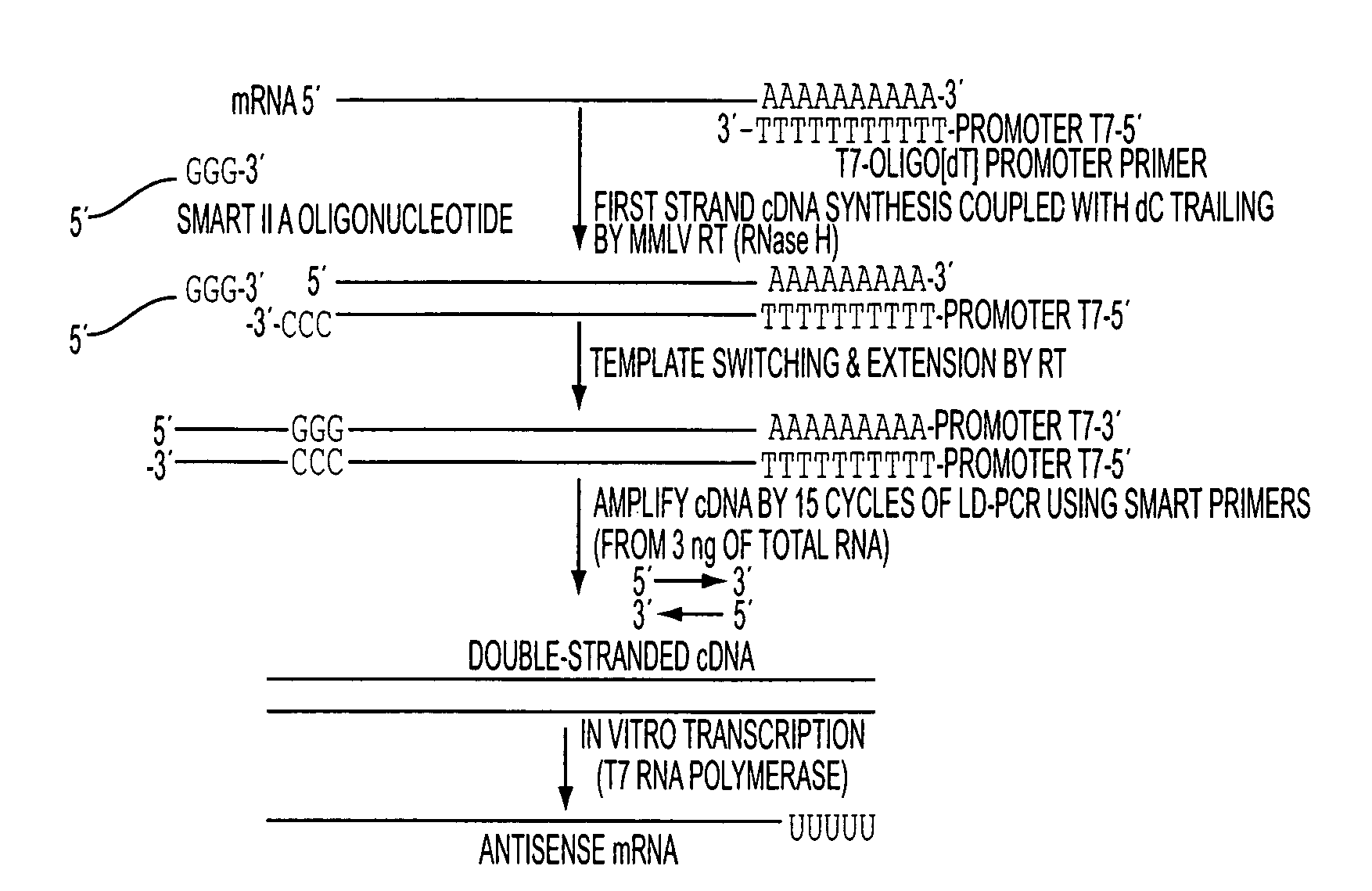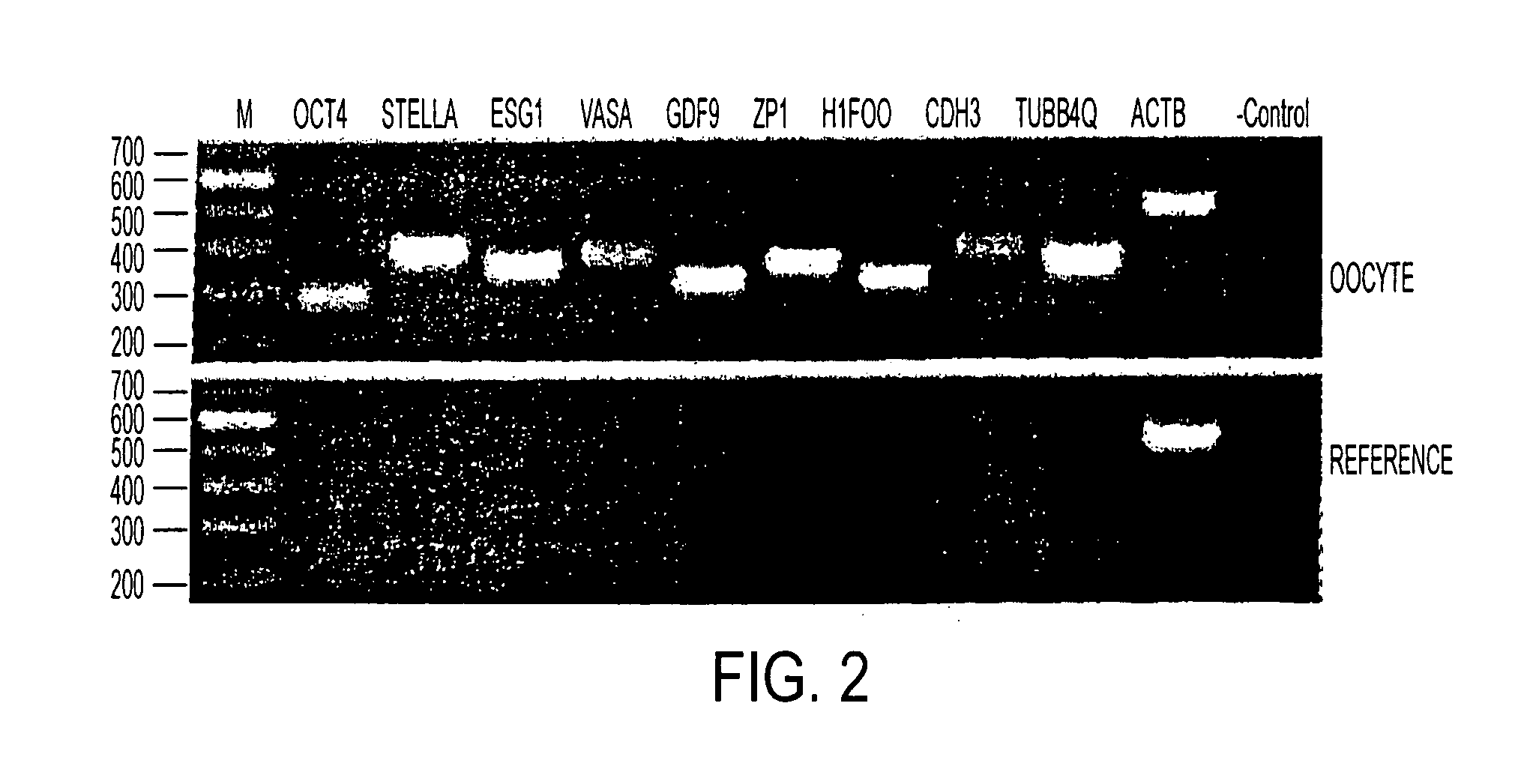Human transcriptome corresponding to human oocytes and use of said genes or the corresponding polypeptides to trans-differentiate somatic cells
a human oocyte and transcriptome technology, applied in the field use of said genes or the corresponding polypeptides to transdifferentiate somatic cells, can solve the problems of small number of genes analyzed, lack of comprehensive picture of human oocyte transcriptome, and relatively unknown oocyte transcriptome and its functional significance in the human
- Summary
- Abstract
- Description
- Claims
- Application Information
AI Technical Summary
Benefits of technology
Problems solved by technology
Method used
Image
Examples
experimental examples
[0059]The Materials and Methods below were used to derive the human transcriptome or set of genes upregulated by in vivo matured metaphase II human oocytes.
Materials and Methods
[0060]Oocyte Collection Total RNA Extraction, and Reference RNA.
[0061]Human oocytes were obtained from three patients undergoing an assisted reproductive treatment (ART) at the Unit of Reproductive Medicine of Clinica Las Condes, Santiago, Chile. It is important to emphasize that the routine in vitro fertilization protocol at Clinica Las Condes calls for fertilizing only those oocytes that will be transferred into the uterus of the patient. Therefore, there is always a surplus of oocytes. We then had the opportunity to use specific criteria to select donors as follows: (i) Supporting Materials and Methods, which is published as supporting information (See Ref. 50).
[0062]Three groups of 10 oocytes each were used. Total RNA was isolated following the guanidium thiocyanate method (Ref. 45) by using the PicoPure ...
example 1
Validation of Amplification Fidelity (Amplified vs. Nonamplified RNA)
[0080]A critical step in the analysis of gene expression on small samples is the faithful amplification of mRNA molecules present in the sample. We have designed a PCR-based amplification system using the combination of SMART II A oligonucleotide (Clontech, Mountain View, Calif.) and T7-Oligo(dT) promoter primers (CRL RNA amplification protocol) (FIG. 1A). We isolated total RNA from a human cell line and 20, 3, and 1.5 ng input total RNA was amplified using the CRL amplification protocol. For each experiment, 15 μg of fragmented amplified RNA (aRNA) was hybridized to a single Affymetrix Human Genome U133 Plus 2.0 array. Nonamplified RNA from the same original sample (1 μg) was run in parallel by using the MessageAmp II aRNA Kit (Ambion, Austin, Tex.). Gene expression results from both amplified vs. nonamplified RNA samples were compared, and the correlation coefficients were found to be 0.94 (FIG. 1B), 0.93, and 0....
example 2
Validation of Microarray Data
[0081]A selected list of genes was used to validate the microarray results by RT-PCR (FIG. 2). These genes were found to be present in the oocyte sample and absent in the reference RNA. FIG. 2, contains RT-PCR verification of the GeneChip array result. Loading orders of the gel were as following: M, 100 bp molecular weight standards with sizes as indicated on the left margin; OCT4, POU domain, class 5, transcription factor 1; STELLA, DPPA3, developmental pluripotency-associated 3; ESG1, embryonal stem cell-specific gene 1; VASA, DEAD box RNA helicase; GDF9, growth differentiation factor 9; ZP1, zona pellucida glycoprotein 1; H1FOO, H1 histone family, member O, oocyte-specific; CDH3, cadherin 3, type 1, P-cadherin (placental); TUBB4Q, β-tubulin; ACTB, β-actin; and negative control with no DNA template.
PUM
| Property | Measurement | Unit |
|---|---|---|
| Fraction | aaaaa | aaaaa |
| Electric charge | aaaaa | aaaaa |
| Electric charge | aaaaa | aaaaa |
Abstract
Description
Claims
Application Information
 Login to View More
Login to View More - Generate Ideas
- Intellectual Property
- Life Sciences
- Materials
- Tech Scout
- Unparalleled Data Quality
- Higher Quality Content
- 60% Fewer Hallucinations
Browse by: Latest US Patents, China's latest patents, Technical Efficacy Thesaurus, Application Domain, Technology Topic, Popular Technical Reports.
© 2025 PatSnap. All rights reserved.Legal|Privacy policy|Modern Slavery Act Transparency Statement|Sitemap|About US| Contact US: help@patsnap.com



